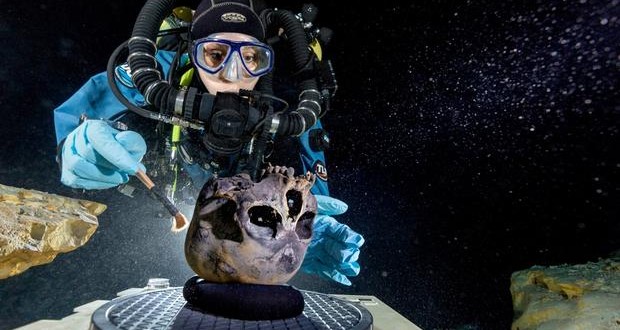Researchers said Thursday that they have identified a nearly complete skeleton in an underwater Mexican cave, a discovery that could help resolve a longstanding debate about the origins of the first people to inhabit the Americas.
In 2007 a team of Mexican divers uncovered a full skeleton of a young woman they call Naia. Scientists believe she fell to her death into a deep pit in the Yucatan Peninsula, now immersed in water. A year and a half ago, scientists brought on researchers from the University of New Mexico to learn more about Naia. They sent the New Mexico team one of Naia’s teeth so they could use a special dating technique to find out how old she really is.
“We scratched out three tiny samples of dentine from the tooth,” says UNM Research Scientist Victor Polyak.
Polyak worked on dating Naia’s tooth but he and his team couldn’t get reliable dates from the tooth alone. Luckily, divers also uncovered small crystals from Naia’s skeleton.
“The age of those florets would give a minimum age for Naia,” explains Polyak.
While another set of researchers used a different dating technique, UNM scientists narrowed down the Naia’s age using state-of-the-art technology on the small crystals.
“The Carbon 14 age provided a maximum age for Naia, our 12,000 year age using Uranium Thorium dating from this lab gave a minimum age of 12,000,” Polyak explains.
The dating pinpoints Naia’s age within 1,000 years, leading scientists to believe she’s between 12,000 years old and 12,900 years old. Yet, even more important than her age is what scientists say about her DNA. UNM professors say it draws a link between modern day Native Americans and ancestral Americans.
“She does not look like modern Native Americans in terms of her bone structure and everything else but, the DNA work show she shares the same strains shared by all modern Native Americans in the Americas,” says Asmerom.
Spokespeople with the University of New Mexico say National Geographic is set to do a one hour special on Naia at a later date.
Agencies/Canadajournal
 Canada Journal – News of the World Articles and videos to bring you the biggest Canadian news stories from across the country every day
Canada Journal – News of the World Articles and videos to bring you the biggest Canadian news stories from across the country every day



